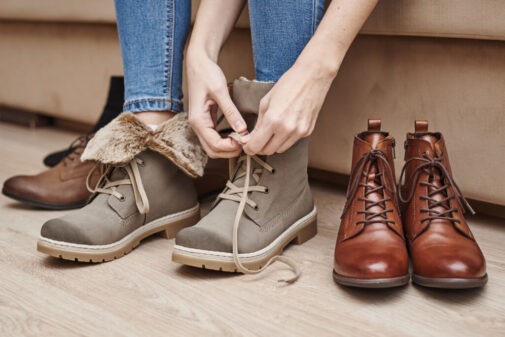Foot Care Should Not Hibernate Just Because It Is Winter

Pulling out the winter boots and putting away the sandals each winter does not mean you have to stop caring for your feet just because they are out of sight.
“Feet are the pillars of our body,” says Dr. Kumar Raigaga, podiatrist, for Advocate Medical Group in Aurora, Ill. “If the feet are out of alignment or are in pain, then our ankles, knees, hips and back must compensate.”
One common foot issue is foot bunions. Foot bunions are progressive deformities where the big toe starts turning outward towards the other four toes. This causes the inner first metatarsal bone to jut in, creating a pressure point when in shoes. In some cases, the bursa (the fluid sac which naturally goes between your bone joints and soft tissue) at that pressure point can become inflamed and painful as it rubs against your shoes.
Bunions can be hereditary, but the big toe also can turn outward due to ill-fitting shoes, injuries or trauma and arthritic changes. Usually, people with flat feet and low arches are susceptible to developing bunions because your foot joints are looser. Women are about ten times more prone to develop painful bunions than men. And women generally tend to have more foot problems than men because their shoes can be narrower and pointier. Plus, hormonal changes during pregnancies can further flatten and affect foot structure.
Bunion treatments range from quick solutions to surgery. Simple treatments include proper shoes with a wide enough toe area and supportive soles. Orthotics or arch supports can provide additional support to offload the pressure in the joint, and gel padding can cushion the area. Icing, anti-inflammatory medication and stretching or massages also can relieve pressure and swelling. However, if discomfort is not relieved with these do-it-yourself measures, it is recommended that you speak with a podiatrist or foot & ankle specialist to discuss cortisone injections and/or possible surgery if the bunion is severe.
So how do you avoid bunions in the first place? Dr. Raigaga shares tips on how to prevent not only bunions but future foot problems too:
- Shoe shopping: When trying on shoes, don’t assume they will stretch out enough to become comfortable if they don’t feel right the minute you try them, opt for a wider or larger size. Remember your feet change throughout your life, and they generally get wider and longer as we age. Pointy shoes and high heels can exacerbate bunions further.
- Lose weight: The average person takes about 5,000 steps a day, and our entire body weight is supported by the feet. Being overweight can exacerbate foot problems and losing weight can greatly reduce the pressure and strain on your feet with every step.
- Stretch daily: There are plenty of good foot stretches that don’t take long to do. “As we have more birthdays, we generally get less flexible in our body,” Raigaga says. “Overstraining stiffened joints, ligaments, tendons and muscles can create micro-tearing which can lead to chronic inflammation. Daily stretching is vital to avoid injury.”
“Having daily foot pain is not normal,” states Dr. Raigaga, “If there is no change to your pain after trying foot supports, over-the-counter meds, and massage, please seek help from a professional specialist to prevent further damage and continued pain.”
Article contributed by: Jennifer Benson
Tags: #bunions, #footcare, #healthcare, #parishnurse

Comments are closed here.